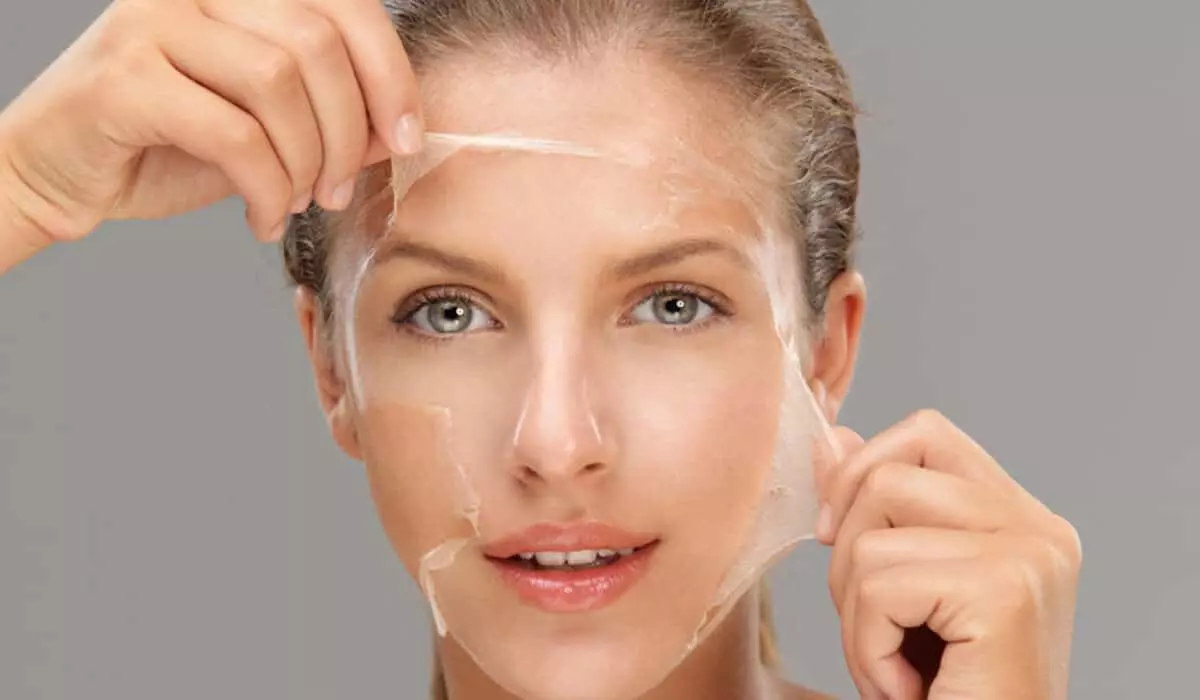Skin Health Alert: Consult dermatologist before using skin peels to avoid damage
As per dermatologists, peels can be superficial, medium and deep, depending on how far they penetrate the skin
By Sulogna Mehta
Hyderabad: A lot of people use various fruit-based and chemical-laced peels to remove dead cells, exfoliate and improve the appearance of skin non-invasively. While applying home-made fruit-based natural peels has been popular for ages, nowadays chemical peels are increasingly becoming popular, with medium-type peels growing in demand due to their effectiveness in addressing several dermatological concerns.
However, medical experts caution against indiscriminate use of peels, especially chemical peels, without understanding one’s skin type and without consulting doctors for personalised needs and treatment advice.
As per dermatologists, peels can be superficial, medium and deep, depending on how far they penetrate the skin. The duration of the effects also varies accordingly. Dr Sravya Tipirneni Reddy, dermatologist, cosmetologist and trichologist at Manipal Hospitals clarifies various questions about face peels.
Homemade peels from fruit and dairy
Legend says that Queen Cleopatra bathed in goat’s milk and French women in the 17th century scraped off crushed grapes from the bottom of wine barrels and washed their faces with it. While natural ingredients like fruits have some exfoliating properties, a dermatologist wouldn’t recommend applying homemade fruit-based peels to all skin types as these contain mild chemicals derived from fruit and lactic acids. Individual skin sensitivities and potential for irritation vary greatly. Some of the most used fruit peels are based on papaya, orange, cucumber, tomatoes, and potatoes and combined with honey, yoghurt or milk.
Chemical peels
Interestingly, most chemical peels are made from natural ingredients. Glycolic acid peels are derived from sugarcane, Kojic acid peels come from wild mushrooms, lactic acid peels are made from sour milk, arbutin peels are derived from berries and so on!
Chemical peels use a chemical solution to improve and smooth the texture of the facial skin by removing its damaged outer layers. It causes the skin to separate, flake off and allows new skin to regenerate. It is typically performed on the face, neck, hands, feet, back or around the eyes. The technique is used to improve the appearance of the skin, in terms of acne, marks, pigmentation and fine lines. Chemical peeling is a simple procedure, which requires no anesthesia, takes only a few minutes in a cosmetic clinic and has a very minimal recovery time.
Chemical peels can address acne, aging
Chemical peeling is a time-tested method for rejuvenation and restoring the skin to its original youthful appearance. It is helpful for those individuals with facial blemishes, wrinkles, under-eye dark circles, sun-damaged skin and uneven skin pigmentation.
Chemical peels can also treat acne, post-acne pigmentation and scarring, and remove pre-cancerous growths. The precise formula used may be adjusted to meet each patient’s needs. The new skin is temporarily more sensitive to the sun.
Chemical peeling may be combined with laser resurfacing, and cosmeceutical preparations to achieve cost-effective skin rejuvenation customised to the needs of the individual patient. However, if one has a history of herpes (cold sores), they must inform their dermatologist before the procedure.
Effects of peels and limitations
The effects vary depending on the type of peels used. For example, the effect of superficial peels typically lasts two to four weeks, requiring multiple treatments for long-term improvement. The effect of medium peels can last for three to six months, often needing one or two sessions for noticeable results.
Chemical peels can significantly fade pigmentation but may not always make them totally disappear. They cannot tighten lax skin or treat deep scarring. They may not bring about appreciable change in the pore size. They do not remedy facial redness or broken vessels.
Contraindications for medium and deep peels: Individuals with darker skin tones, active acne, pregnant or breastfeeding women, and those with certain medical conditions or taking photosensitising medications should avoid medium or deep peels. These peels reach the papillary dermis or deeper, depending on the type.
Post-Peel Skincare: Following a peel, the dermatologist will recommend a specific skincare routine, typically including gentle cleansers, moisturisers, and broad-spectrum SPF (sunscreen). At the end of the peel, a neutralising solution is applied to the area and washed off with cold water.
Avoiding other creams, lotions, and make-up for a few days promotes optimal healing and prevents irritation.
Combining chemical peels with laser resurfacing: Laser resurfacing uses concentrated light beams to remove damaged skin layers, promoting collagen production and skin tightening. It can be combined with chemical peels for deeper rejuvenation in some cases.
Superficial peels: Superficial peels are virtually safe in all skin types and have no long-term side effects. Depending upon the type of peel, a reaction similar to sunburn occurs following a chemical peel. This usually involves redness, followed by scaling that ends within one to five days. It is important to avoid overexposure to the sun after a chemical peel since the rejuvenated skin is fragile and more susceptible to complications. Given the nature of the procedure, patients generally need multiple treatments on a fortnightly or monthly basis to reach a desired result. The number of peels carried out ranges from 3 to 15 depending on the condition being treated.
Over-the-counter peel strips: Most over-the-counter peel strips are superficial peels, targeting the uppermost layer of skin. They may be helpful for mild concerns like dry patches or dullness but offer limited effect on deeper issues like wrinkles or pigmentation.
Allergies and side effects: “Peels can cause allergies in some individuals. Other potential side effects include temporary stinging, redness, peeling, and sun sensitivity. If you experience severe or persistent irritation, stop using the peel and consult your dermatologist immediately. During the peeling procedure, most patients experience tingling, and a warm to somewhat hot sensation which lasts about five to ten minutes. However, self-treating with homemade peels or relying on generic advice can be detrimental. Consulting a dermatologist ensures safe and effective treatment tailored to your unique skin needs,” said Dr Sravya.